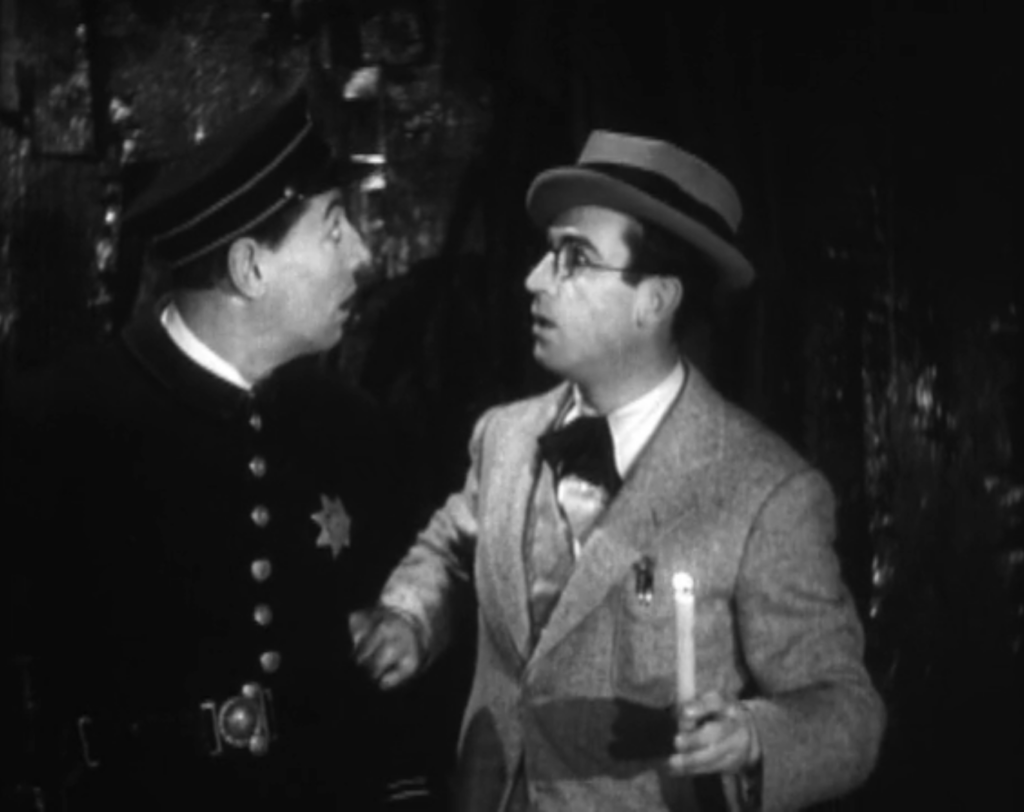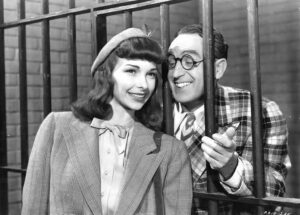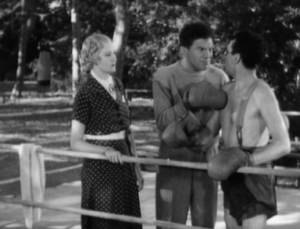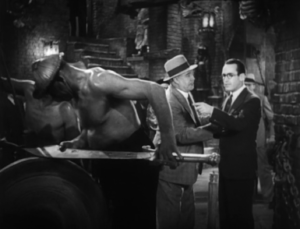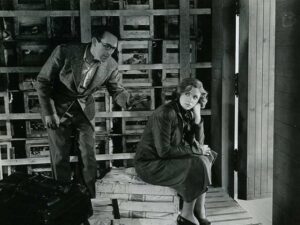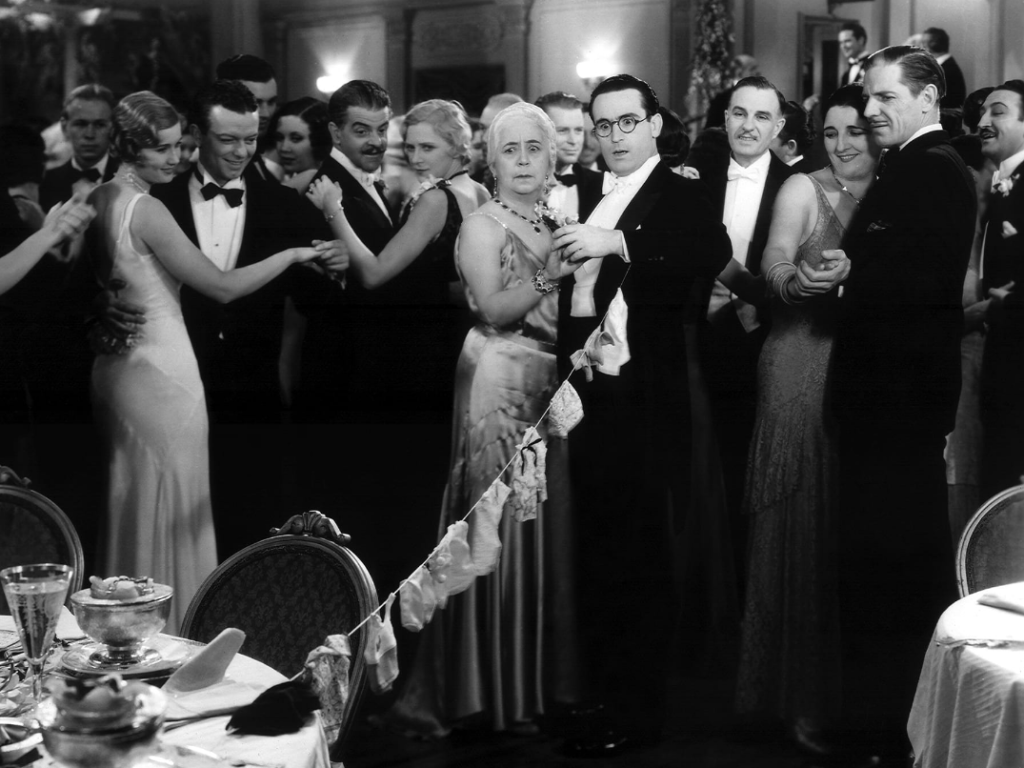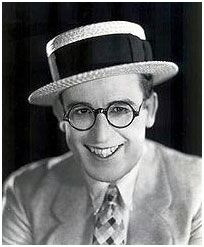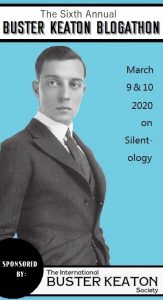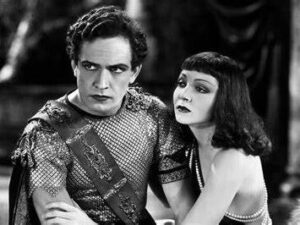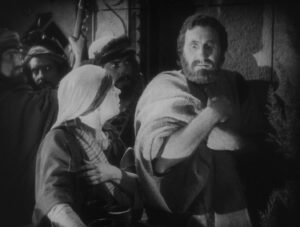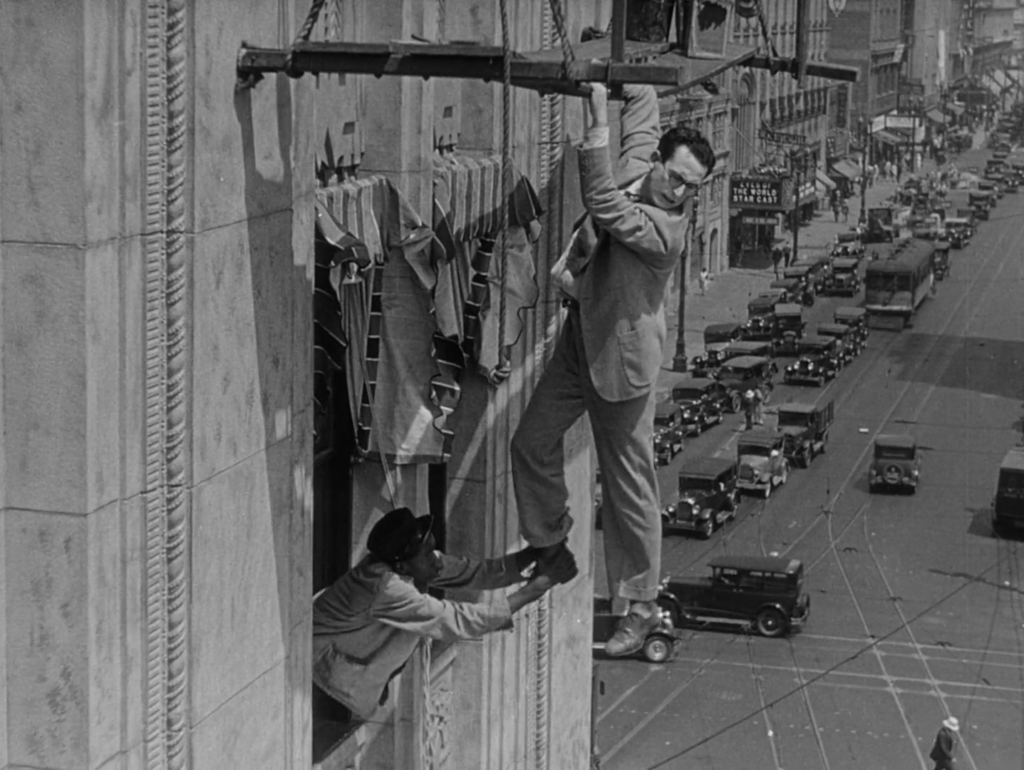
Of the three silent clowns, Lloyd’s sound career is the least discussed. Keaton’s MGM talkies stand as an example of Buster’s loss of creative and personal control and yet another example of MGM mishandling its comedic talent. Chaplin, after waiting a decade before diving into the new medium, created undeniable classics in The Great Dictator and Monsieur Verdoux in the 1940s. Harold Lloyd’s sound films lie somewhere between the middle of the other two comic geniuses, not quite good enough to receive universal praise and not bad enough for fans to decry their very existence.
That’s not to say Lloyd’s talkies are sluggish or boring. Quite the opposite! Once Lloyd successfully transitioned his unique style of comedy to sound, he made a string of watchable and rewatchable comedies that deserve much more love. Lloyd took his classic boy-with-glasses character, playing him all the way up to his final film appearance in 1947, into new genres and comedic styles. Even amongst his creaky early sound films, fans of his silent work and those completely unfamiliar with Lloyd’s previous work will find something to love
To celebrate Harold Lloyd 130 years after his birth, I rank his seven sound films and pair each film into a double feature with one of his silent films:
7. Welcome Danger (1929)
Llloyd and frequent co-star Noah Young find their way through the dark and through the new technology of sound.
Midway through the production of his 12th silent feature film, Lloyd scrapped most of what he had shot to pivot to convert the production into his first sound film. Welcome Danger follows a clumsy botanist Harold Bledsoe (Lloyd) who reluctantly takes over his late father’s post as a famous San Francisco police detective. He quickly becomes embroiled in a risky investigation of a Chinese opium den while pursuing a girl he meets in the city (Barbara Kent).
Lloyd, the rare silent comedian who had no previous stage experience, never manages to translate much of his humor to sound in his first foray into verbal comedy. The film struggles mightily with pacing running almost two hours, longer than any of his previous or subsequent films. The hit-or-miss humor fails to cover up a threadbare story that fails to create distinctly interesting characters or mesh Lloyd’s love interest with his investigation.
Despite the film’s rough edges, Lloyd shows his willingness to experiment with the new technology. One striking scene occurs when Lloyd and Noah Young find themselves trapped in a dark basement lair. The screen goes black for several seconds and all we hear are the two fussing around in the dark trying to find a light. It’s a good joke that could only have been achieved with sound.
Even if the final product wasn’t anywhere near Lloyd’s best work, the occasional laughs found in Welcome Danger suggested that with a little more time, Lloyd would find the filmmaking skills needed to succeed in sound.
Silent Double Feature: Speedy (1928). Lloyd’s last silent feature acts as a great foil to his first sound film providing a fascinating look at what comedic aspects translate well into sound and which didn’t.
6. Feet First (1930)
Lloyd finds himself dangling from a building yet again.
Feet First finds Lloyd with a much more reliable premise than his first sound effort. Trying to impress his boss’ secretary Barbara, who Harold mistakenly thinks is his boss’ daughter, Harold tells Barbara he is a millionaire tycoon instead of a humble shoe salesman. Much of the remainder of the film involves Harold trying to cover up his little fib, providing an apt motivation for various physical shenanigans and gags.
The best section of the film takes place on a steamliner Harold has stowed away on to follow Barbara and his boss. One of the ship’s magazines includes a picture of Harold in an advertisement. Naturally, he must grab every magazine on the ship to keep his charade successfully going. Reminiscent of similar running gags in many of his silent films, chasing passengers around the ship and preventing anyone from picking up a magazine for a whole reel allows Lloyd to showcase his unique physical humor.
Overall Feet First is better made and much more entertaining than Welcome Danger but is paced rather slowly when physical gags are not at the forefront. The film’s distinct three acts feel like three separate two-reelers spliced together with little connection. Starting at a shoe store and jumping to a cruise ship, the final third finds Harold back in the city scaling a building in a cheap imitation of his classic climactic set piece in Safety Last. Despite its shortcomings, there is plenty to like in Lloyd’s second, more confident sound effort.
Silent Double Feature: Safety Last (1923). After watching Feet First‘s final act, plop in Safety Last! to see how much better Lloyd’s human fly set piece works the first time.
5. The Sin of Harold Diddleback (1947)
Harold certainly has aged since The Freshman but his leading ladies haven’t.
After completing Profesor Beware in 1938, Lloyd didn’t intend to retire; however, he became involved with other hobbies and activities and as the years moved on, he didn’t find any material or stories he’d like to bring to the screen. This changed when famed writer-director Preston Sturges coaxed him out of retirement to make his first film in almost a decade. Pitched as a sequel to The Freshman, The Sin of Harold Diddlebock boasted a plethora of talented character actors such as Rudy Vallee, Margaret Hamilton, and Franklin Pangborn in what ultimately become Lloyd’s last film.
After landing a job in the locker room after the climactic football match in The Freshman, Harold Diddlebock wastes away twenty years of his life working in a dead-end, thankless desk job. Getting fired after 23 years of service in the bookkeeping departure, a decidedly middle-aged Harold decides to for the first time enjoy his life by going out on the town. After a drunken night with a whole new cadre of lowlife friends, the next day Harold must undo the damage of his bender and get rid of a circus he, unbeknownst to the now sober Harold, bought the previous night.
The first half of the film is a reflexive look at Lloyd’s career. Turning his character’s optimism on its head, we now find him a corporate sellout, ripped of the very cheerful spontaneity and hopeless romance at the core of his boy with glasses character. Unfortunately, the second half of the film abandons Harold’s soul-searching instead focusing on his dreadfully boring attempts to sell off his circus. The later part’s antics, including Harold fighting a lion on the edge of a tall building, don’t live up to Sturges’ or Lloyd’s comedic talent.
Even if The Sin of Harold Diddlebock remains an artistic disappointment, it is always fun to see Lloyd in whatever he is in. If you get a chance, see the new restoration of the film by the UCLA Film and Television Archive that adds a couple of scenes edited out in a 1950 re-release.
Silent Double Feature: The Freshman (1925). Why be satisfied with a couple of clips of The Freshman in the prologue when you can watch the whole film on top of a double bill with The Sin of Harold Diddlebock?
4. The Milky Way (1936)
Harold finds himself in over his head with tough guys and wisecracking dames.
Instead of merely sticking to his own formula of comedy, Lloyd adapted to the times by undertaking his own screwball comedy with The Milky Way. Of Harold Lloyd’s sound films, The Milky Way received the most praise from critics. After the newspaper breaks a story that a milkman knocked out the world middleweight champion (William Gargan) in a street brawl, the fighter’s publicist (Adolphe Menjou) forces the milkman (Harold Lloyd) into a series of fixed fights to recuperate his champion’s public image and career.
The film is adequate, with silent comedy veteran Leo McCarey at the helm and solid performers like Adolphe Menjou and Lionel Stander, but ultimately rings hollow. The character development is almost nonexistent and multiple romances aren’t given the time to build up to anything the audience genuinely cares about. Some of the boxing scenes are fun but it’s a comic genre that has been done better by others. The Milky Way remains a serviceable comedy largely overshadowed by contemporary screwball comedies that provide much more laughter and dynamic romantic relationships.
Silent Double Feature: The Kid Brother (1927). Harold’s fighting style in the boxing ring translates well to the final climatic fight between the scrawny, scrappy Harold and the Goliath-like villain.
3. The Cat’s-Paw (1934)
Lloyd goes to a much darker place than usual in this oddball comedy.
Harold plays Ezekiel Cobb, a Christain missionary who moves back to America hoping to find a wife after growing up in China. Quickly upon his return to his birth country, Cobb is hoodwinked into running for the city’s corrupt political machine as a dummy candidate. After a surprising victory, Cobb takes on the powerful city mob applying his unorthodox blend of American and Chinese philosophy to clean up the city of crime following his victory.
The Cat’s-Paw sticks out from Lloyd’s sound filmography. First off, Lloyd adapted a pre-existing story instead of constructing one around a set of pre-determined physical gags. Lloyd also largely abandoned physical gags, relying almost exclusively on verbal comedy. The most surprising aspect of the film is Cobb’s bizarre, near-fascist ruling style, making Harold the small-town version of Walter Huston’s president in Gabriel Over the White House flouting the law to take matters into his own hands. Not surprisingly, characters casually throw around racist slurs when talking about Lloyd’s Chinese associates and friends.
Succeeding on such a wild departure from his usual style, Lloyd shows off both his filmmaking prowess and confident determination. Having three sound pictures under his belt certainly helped Lloyd nail the verbal humor. Being surrounded by apt performers from Una Merkel to Nate Pendelton certainly didn’t hurt either. Even without Lloyd’s trademark physical comedy, The Cat’s-Paw remains an enjoyable political comedy.
Silent Double Feature: Why Worry? (1923). While in The Cat’s-Paw Lloyd travels to America to join a violent fascist takeover of the government, Why Worry? finds a hypochondriac Harold and his nurse roped into a revolution on a small tropical island.
2. Professor Beware (1938)
Professor Lambert afraid his new romantic interest is the fulfillment of a fatal ancient prophecy.
After producing his own films through his own company for the past two decades, Lloyd’s Professor Beware was produced by Paramount. Despite this change in production companies, Professor Beware still feels distinctly like a Harold Lloyd picture, finding him returning to his more usual style after his previous two efforts The Cat’s-Paw and The Milky Way.
Lloyd plays an archaeology professor Dean Lambert who, after translating stone tablets detailing the ancient Egyptian Neferus’ tragic death at the hands of his lover, believes himself to be the reincarnated Neferus and similarly doomed to meet his death at the hands of a romantic partner. Running away from the police after a misunderstanding caused by meeting a woman Jane, Professor Lambert must dodge police, love, and tragic death while escaping the country to attend a potential career-defining archaeological dig in Egypt.
The film’s tepid reception from both critics and audiences played a large part in Lloyd’s semi-retirement. I’m glad to report, however, that out of Harold Lloyd’s sound films Professor Beware remains one of the most entertaining. The cat-and-mouse chase across the country propels the story forward providing plenty of entertaining gags. The film’s climactic fight on a yacht with hordes of ruffians offers a much more comedic and fitting finale than what his final appearance in Sturges’ film would end up being.
Silent Double Feature: Grandma’s Boy (1921). Both films feature a historical artifact (the tablet in Professor Beware and Harold’s grandfather’s Civil War token in Grandma’s Boy) giving Harold confidence to fight his antagonists, proving that Lloyd always stuck to his consistent character.
1. Movie Crazy (1932)
Hijinks ensue when Lloyd accidentally trades jackets with a magician.
In his third sound feature, Lloyd creates a picture that successfully captures the spirit of his silent features. Compared to Welcome Danger and Feet First, Movie Crazy zooms by at a tight 90 minutes with little to no awkward dialogue or glacially paced exposition. Similar to Merton of the Movies, Harold moves to Hollywood after mistakingly securing a screen test when he accidentally mails a stock image of a model to the studios instead of his own headshots. A horrendously, inept ham, Harold epically fails his screen test and wreaks havoc on set before finding his place as a comedic character. Along the way, he falls in love with an actress who he doesn’t recognize when he sees her out of costume.
The central romance provides a solid lynchpin for the story with the confident Constance Cummings proving to be a great match for Lloyd’s clumsy character. Lloyd hits a winning formula meshing together a sturdy story chockfull of narrative tension with his trademark physical comedy. A lengthy gag involving Lloyd mistakenly wearing a magician’s suit at a dance function stands out as the funniest part of the film, being reminiscent of Lloyd’s poorly sewed suit falling apart in The Freshman.
Out of all his sound films, Movie Crazy best captures the optimism of Lloyd’s boy with the glasses character that he perfected in the silent era. Movie Crazy is the perfect starting point for any Lloyd fan to experience his successful transition to the talkies and a comedy that stands toe to toe with others of the Pre-Code era.
Silent Double Feature: Girl Shy (1924). Movie Crazy features the strongest of Harold’s talking leading ladies while Girl Shy features his best romantic lead in Jobyna Ralston and my personal favorite of all his sound and silent pictures.
Except for Professor Beware and The Sin of Harold Diddlebock, all of Harold Lloyd’s sound films are at the time of this writing streaming on the Criterion Channel along with dozens of his sound features and shorts. Visit my complete ranking of Harold Lloyd’s eleven silent features to find some of Lloyd’s and silent Hollywood’s best films.
